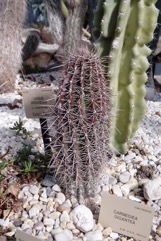Saguaro Cactus, Giant cactus

A subtropical plant. Mature plants will tolerate temperatures down to -7°C. It needs temperatures from 5-30°C. Seedlings need protection from cold. They can tolerate intense heat and sun. They must have acid soil. It suits hardiness zones 9-11. Hobart Botanical Gardens.
Also known as:
Kaktus karnegi, Pitayas, Sahuaro
Synonyms
- Cereus giganteus Engelm.
Edible Portion
- Fruit, Seeds, Seeds - oil
Where does Saguaro Cactus grow?
Found in: Asia, Australia, Central America, Indonesia, Mexico, North America, SE Asia, Tasmania, United States
Notes: There is only one Carnegiea species. (It is often shown as scenery in movies.)
Status: Saguaro fruits were a major food staple of the Papago and Pima Indians;
Growing Saguaro Cactus, Giant cactus
Cultivation: It is grown only from seed. The seedlings have few branches and many spines. It can also be grown from cuttings.
Edible Uses: The fruits are processed (i.e. dried, fermented, canned) and stored for year-round use. Seeds, rich in fat, are ground for use as flour and in porridges. The seed can be turned into a paste. The fruit can be used for syrup or made into conserve. The fruit are eaten. The red pulp of the fruit can be eaten fresh. The seeds are ground into flour and used in soups, sweetmeats and as a buttery paste on tortillas. The seed also produce an edible oil.
Production: It is slow growing. It grows at 20 cm per year. It may only flower after reaching 3.5 m high. The fruit fall naturally and are dried by the sun and collected. They can be stored. The fruit ripen in one month.
Nutrition Info
per 100g edible portion| Edible Part | Energy (kcal) | Protein (g) | Iron (mg) | Vitamin A (ug) | Vitamin c (mg) | Zinc (mg) | % Water |
|---|---|---|---|---|---|---|---|
| - | - | - | - | - | - |
Saguaro Cactus, Giant cactus Photos

References
Andersohn, G., 1983, Cacti and Succulents. EP Publishing. p 68
Anderson, E.F., 2001, The Cactus Family, Timber Press. p 49, 138
Anderson, M., 2002, The World Encyclopedia of Cacti and Succulents. Hermes House, New York. p 55.
Beckstrom-Sternberg, Stephen M., and James A. Duke. "The Foodplant Database." http://probe.nalusda.gov:8300/cgi-bin/browse/foodplantdb.(ACEDB version 4.0 - data version July 1994)
Benson, L., 1969, The Native Cacti of California. Stanford University Press. p 173 (As Cereus giganteus)
Bircher, A. G. & Bircher, W. H., 2000, Encyclopedia of Fruit Trees and Edible Flowering Plants in Egypt and the Subtropics. AUC Press. p 84
Brickell, C. (Ed.), 1999, The Royal Horticultural Society A-Z Encyclopedia of Garden Plants. Convent Garden Books. p 231
Chapman, P and Martin, M., 1989, Exotic Cacti, HP Books p 57
Cundall, P., (ed.), 2004, Gardening Australia: flora: the gardener's bible. ABC Books. p 332
Darley, J.J., 1993, Know and Enjoy Tropical Fruit. P & S Publishers. p 19
Etherington, K., & Imwold, D., (Eds), 2001, Botanica's Trees & Shrubs. The illustrated A-Z of over 8500 trees and shrubs. Random House, Australia. p 182
Etkin, N.L. (Ed.), 1994, Eating on the Wild Side, Univ. of Arizona. p 70
Facciola, S., 1998, Cornucopia 2: a Source Book of Edible Plants. Kampong Publications, p 63
Fouqué, A. 1972. Espèces fruitières d'Amérique tropicale. Institut français de recherches fruitierès outre-mer
Hedrick, U.P., 1919, (Ed.), Sturtevant's edible plants of the world. p 180
Heywood, V.H., Brummitt, R.K., Culham, A., and Seberg, O. 2007, Flowering Plant Families of the World. Royal Botanical Gardens, Kew. p 77
Hibbert, M., 2002, The Aussie Plant Finder 2002, Florilegium. p 60
Huxley, A. (Ed.), 1977, The Encyclopedia of the Plant Kingdom. Chartweil Books. p 71, 160
Innes, C. and Glass, C., 1997, The Illustrated Encyclopedia of Cacti. Sandstone Books. p 38
J. New York Bot. Gard. 9:188, t. 32. 1908
Kermath, B. M., et al, 2014, Food Plants in the Americas: A survey of the domesticated, cultivated and wild plants used for Human food in North, Central and South America and the Caribbean. On line draft. p 186
Kiple, K.F. & Ornelas, K.C., (eds), 2000, The Cambridge World History of Food. CUP p 1836
Kiple, K.F. & Ornelas, K.C., (eds), 2000, The Cambridge World History of Food. CUP p 1847 (As Cereus giganteus)
Martin, F. W., et al, 1987, Perennial Edible Fruits of the Tropics. USDA Handbook 642 p 84
Morley, B. & Everard, B., 1970, Wild Flowers of the World. Ebury press. Plate 175
Pinkava, D. J. 1995. Cactaceae, part 1. Cactus Family: the cereoid cactus. J. Arizona-Nevada Acad. Sci. 29:8.
Plant Ecology - Reviews of Research. 1955, Arid Zone Research VI. UNESCO p 97
Saunders, C.F., 1948, Edible and Useful Wild Plants. Dover. New York. p 110 (As Cereus giganteus)
Segura, S. et al, 2018, The edible fruit species in Mexico. Genet Resour Crop Evol (2018) 65:1767–1793
Sukarya, D. G., (Ed.) 2013, 3,500 Plant Species of the Botanic Gardens of Indonesia. LIPI p 1006
Subik, R., & Kunte, L., 2003, The Complete Encyclopedia of Cacti. Rebo publishers. p 13
USDA, ARS, National Genetic Resources Program. Germplasm Resources Information Network - (GRIN). [Online Database] National Germplasm Resources Laboratory, Beltsville, Maryland. Available: www.ars-grin.gov/cgi-bin/npgs/html/econ.pl (10 April 2000)
World Checklist of Useful Plant Species 2020. Royal Botanic Gardens, Kew
www.desert-tropicals.com